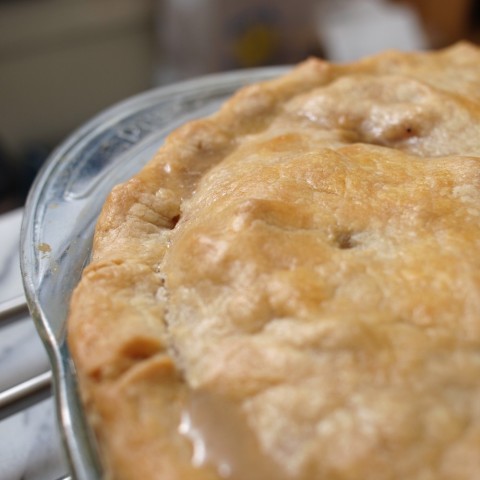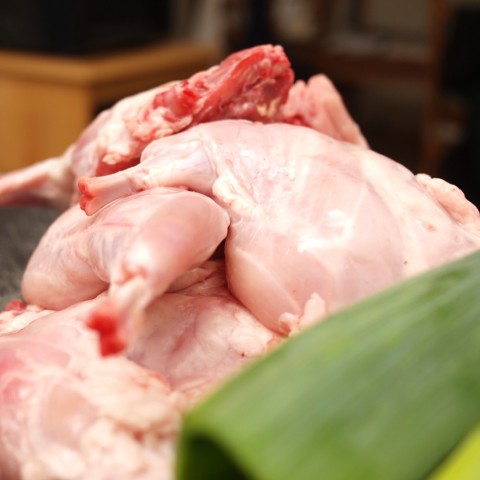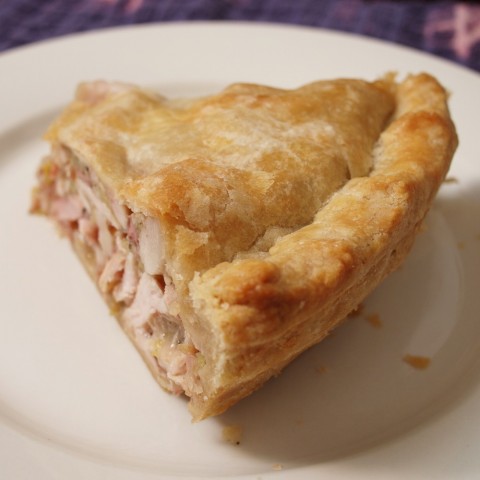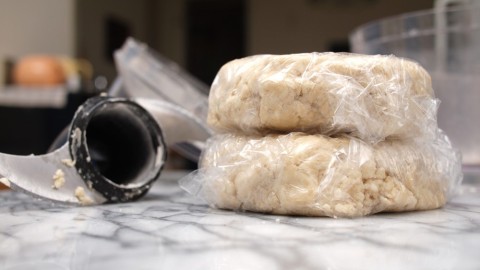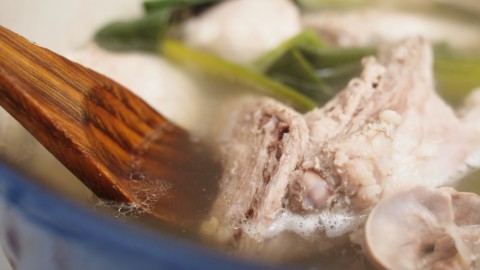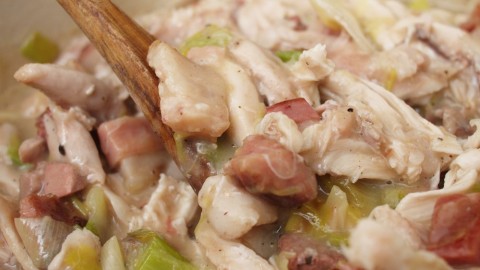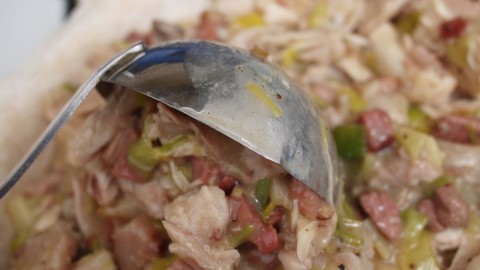I’ve been sitting on this recipe for almost a week, now, not because there’s anything wrong with it, but because I haven’t quite been able to figure out how to make it work for this space.
Here’s the problem: last week, with Easter close at hand, with Elizabeth’s post about carrot soup newly live, and with my recent enthusiasm for savory pastry, I made the decision that my next post here at Twice Cooked was going to have to be a rabbit pie. It appealed to my sense of impropriety — a rabbit for Easter! — and it appealed to my sense of propriety, too — a classic early-spring meal, timed just right for the early spring.
What hadn’t occurred to me at the time was that though I might find delight in a meal of rabbit on the biggest bunny holiday of the year, other folks — folks with some more real attachment to the festival — might not agree. I have occasionally been accused of having a mean streak. And what did not occur to me until I was well into the cooking was that this sort of thing might just be why.
So I tried to justify it.
It’s traditional! I proclaimed with some enthusiasm as I set a slice in front of Sarah for dinner on Sunday night.
No it’s not, she told me flatly, as she had (apparently) told me more than once before. Lamb is traditional. Honey-baked ham is traditional. In the United States, people eat chocolate bunnies for Easter. Not the real kind.
We went back and forth about this point as Sarah gleefully tore through her first helping, and paused only when she got up to get a second slice. This is just like you and Christmas, she told me after a while, considering as she chewed. You willfully misunderstand other people’s holidays so that you can be snarky and serve whatever you want.
Sarah is right, of course. She’s right every November when she tells me that pumpkin ice cream is nobody’s idea of Thanksgiving dessert. She’s right in December when she tells me that people on this side of the Atlantic don’t want a plum pudding, or a chestnut anything, for Christmas dinner. And she’s right when she tells me that there’s no tradition of eating bunny on Easter. Or, at least, not that she or I know of.
But at the risk of confirming my own inward vicious streak, I will assert to you (dear readers!) that though that may be true — though rabbit may not be a traditional part of the Easter meal — it really should be!
For one thing, the symbolism is just too good. There is, after all, an Easter Bunny for a reason.
Since antiquity, rabbits have been associated with fertility, and specifically with the renewed fertility of the spring. It seems that though they enthusiastically multiply all year long, they have a particular disposition to large litters in March, just as the earth is greening up after the long dead of winter.
Moreover, according to the Wikipedia at least, trios of rabbits represent the Trinity in Northern European Christian art. And all over Europe — as Shakespeare (among others) attest, there has been a widely held folk belief that rabbits can reproduce without ever losing their virginity.
But better than symbolism is the fact that rabbit, as a protein, is seasonally appropriate for Easter and absolutely delicious. I know, I know, that Americans don’t eat much rabbit, anyway. But when they’re done right, the domesticated variety has a sort of chickeny flavor (doesn’t everything?), but with a finer texture, and a succulence that one usually only finds in dark meat.
It is possible to make a bad rabbit. The first time I ever tried it, I did a Spanish-style stew, with rice and tomatoes, that ended in a stringy mess that was a chore for everybody but the cats to eat. And yet — especially if you are willing to cook the rabbit gently — I would assert that it is actually pretty difficult to mess up.
Which brings me back to the rabbit pie.
It seems to me that this recipe is, if nothing else, a testament to rabbit’s forgiving nature. Never on this blog have I made for you a dish that was so singularly British, or so singularly old-fashioned. You’ll note that the first step in making the filling is to submerge your meat in water, and cook it for an hour. You’ll notice that leeks, salt, and pepper form the main part of the seasoning. You’ll notice that, in the end, what you get is a mess of rabbit meat that is suspended in its own gravy, and encapsulated in a crust.
This is a recipe, I imagine, that you might more easily place in the Eighteenth Century, or the Middle Ages, than in the present day.
But at the same time, it is undeniably good. There is something about the combination of leek, bacon, and rabbit that evokes a particularly intense kind of umami. There is something about this recipe that, though heavy, is satisfying and not sickening. By the end of this recipe, you’ll have cooked your rabbit for almost two hours. And yet, when it comes out of the oven — when you cut a slice and take a bite — you’ll find that it is rich and moist and not a bit dry.
Try it. You’ll see just what I mean.
For the Crust:
2 1/2 cups Unbleached AP Flour
2 Sticks of Unsalted Butter, chilled and cubed
6 tbsp Water, ice cold
1 1/2 tsp Salt
One egg, beaten with a splash of water
For the Filling:
1 Rabbit, quartered, with its liver and heart if you can manage it
1/2 lb Bacon, cut into small cubes
2 Leeks, cleaned and sliced, their tough top leaves removed and reserved
1/2 Stick of Salted Butter
1/4 cup Unbleached AP Flour
3 Bay Leaves
Water (about 6 cups)
Pepper
Salt
To make the crust: To the workbowl of a food processor, add the flour and salt, and pulse once to mix. Add the cubed butter, and pulse a couple of times, in five second intervals, until it is incorporated and the mixture is the texture of sand. Then add the water, and keep pulsing until it all just barely comes together into a dough.
Remove the contents of the workbowl, splitting them evenly between two pieces of plastic wrap. Use the plastic wrap to shape the dough into pucks, making sure not to work them too much, to prevent gluten from developing. Wrap the pucks, and chill them in the refrigerator for at least half an hour.
At the end of that time, remove one puck of dough from the refrigerator, and on a lightly floured board, roll it into a circle about an inch wider than your pie pan. Lay the rolled dough into the pie pan, pressing it into the corners so that it fits snugly, and use a fork to perforate the bottom. Trim the extra dough, leaving a couple of centimeters hanging over.
Remove the second puck of dough from the refrigerator and roll it out the same way. Lay it on a piece of parchment, and use the parchment to roll it up. Then return both the top and bottom crusts of the pie to the refrigerator.
Remember: you want to roll these crusts just a little bit thick, to keep the liquid from the filling from making them soggy.
To make the filling: Into a pot or dutch oven over medium heat, add the rabbit (minus its liver), leek tops, bay leaves, a couple of peppercorns, a generous pinch of salt, and enough water to just barely cover it all. Bring the water to a simmer (not a boil!), and let the whole thing go for about an hour, until the rabbit is cooked through and tender.
Remove the rabbit and set it aside to cool. Pass the liquid through a strainer, into a bowl or pitcher, and set that aside as well. When the rabbit has cooled, use your fingers to remove its meat from the bone, and to tear it into small-ish chunks. Try not to get any slivers of bone in amongst the meat; and make sure to remove any remaining fat.
Chop the rabbit liver finely. To a sauté pan over medium heat, add the liver, bacon, sliced leeks, a little bit of salt, and about sixty grinds of pepper, and let it cook until the bacon is done but not crisp, and the leeks are soft and translucent. Add the butter. And when it has melted, add the flour, stir it in, and allow it to cook for just a minute, to cook the raw taste out of it.
When the flour is cooked, add about three cups of the reserved rabbit cooking liquid, a little bit at a time, stirring. As it boils, it will thicken. Keep adding liquid until it is the consistency of a slightly thin sawmill gravy. Then add the chunks of rabbit meat, mixing the whole filling together to distribute all the ingredients evenly.
Putting it all together: Put the filling aside to cool for about twenty minutes, and in the meantime, preheat your oven to 400F. When the filling is no longer hot, ladle it evenly into the bottom crust of the pie. It should make a nice heaping mound.
Unroll the second pie crust and lay it over the top. Trim it, pinch the top and bottom pie crusts together all the way around, and then roll the edges up such that they no longer overhang the pie pan. Pinch the crusts again, or use a fork to make a pattern in the lip of the pie. Pierce the top pie crust with a knife, making a pattern of your choice. Then brush the top of the pie with the egg wash, and bake it for 40 minutes, until the crust has turned golden brown.
When the pie is done, allow it to sit for at least a half hour to gel before slicing. Serve with a wedge of Stilton cheese, and enjoy!
